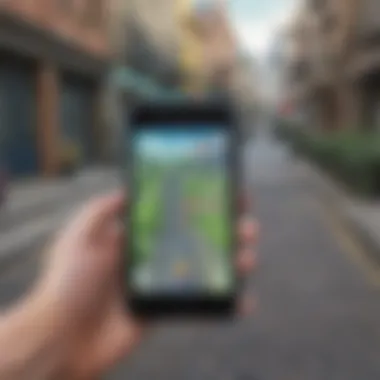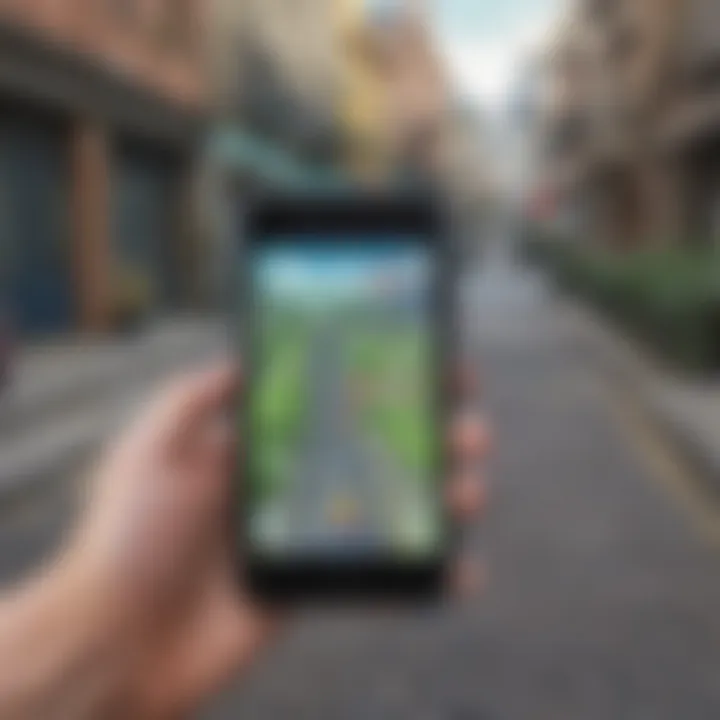Exploring GPS Technology's Role in Pokemon Go


Intro
In recent years, the world of gaming has seen a significant transformation, especially with the introduction of augmented reality games. Pokemon Go, developed by Niantic, stands out as a prime example of how GPS technology has reshaped user experiences, prompting players to venture outside their homes in a quest to catch virtual creatures. This game artfully employs location tracking, allowing Trainers to explore their surroundings and connect with in-game elements in a way that traditional gaming could never achieve.
However, while the excitement of discovering a rare Pokémon on a local park bench can thrill, it also raises pressing questions about privacy and the broader implications of GPS use in mobile gaming. As players traverse real-world locations, the convergence of technology and gameplay mechanics becomes more apparent, leading to an evolving narrative of enhanced user engagement and community interaction.
In this article, we will navigate the influence of GPS technology in Pokemon Go, diving into how it enhances gameplay, the possible privacy concerns that may arise, and strategies for making the most out of your gaming experience. Let's start with an overview of the Pokémon game, which lays the groundwork for understanding the significant impact of GPS technology as players embark on their adventures.
Prologue to GPS Technology
In an age where connectivity is imperative, GPS technology emerges as a cornerstone in the world of mobile gaming, particularly in applications like Pokemon Go. Understanding the intricacies behind this technology is crucial—not just for game developers but also for players who wish to enhance their experience. From tracking locations to navigating augmented realities, GPS creates a seamless connection between the digital and physical worlds that is hard to overlook.
GPS, which stands for Global Positioning System, is a satellite-based navigation system utilized to determine precise locations across the globe. This system isn’t merely about pinning down a point on a map; it’s about enhancing the context in which players engage with their environment. Whether you're on a hunt for rare Pokemon or participating in community events, the ability to accurately pinpoint your location is vital. The implications here extend far beyond gameplay; they touch on social interactions, personal safety, and even local economies.
Understanding GPS Functionality
The functionality of GPS hinges on a network of satellites that orbit the Earth, transmitting signals to GPS receivers. These receivers, which many smartphones now have built-in, decipher these signals to calculate exact locations. The approach is relatively straightforward—measure the time it takes for satellite signals to reach the receiver, and through triangulation, determine latitude and longitude. This accurate location data enables Pokemon Go to offer a dynamic gaming experience based on real-world geography.
One of the key benefits of GPS functionality lies in its user-friendly nature. Most players don’t need to understand the technical details to enjoy the game, but it’s valuable to know that behind the simple interface lies a complex and robust technology that supports real-time interactions. From locating gyms to finding nearby Pokestops, understanding these mechanics can enhance one’s strategy in gameplay.
History and Development of GPS
GPS technology has roots that stretch back to the 1970s, initially designed for military use to assist armed forces in navigation. Over the decades, advancements have transformed GPS into a versatile tool, accessible not just to the military but to civilians as well. In the late 1980s and early 1990s, GPS became increasingly available to the public, leading to its implementation in various fields, including aviation, transportation, and, ultimately, gaming.
The evolution of GPS has paralleled the rapid growth of technology as a whole. As satellite systems improved, so did the accuracy of location tracking. Today, devices can achieve location accuracy within a few meters, a stark contrast to the early systems that had a margin of error in the hundreds of meters. This development, in tandem with the advent of smartphones, set the stage for innovative applications like Pokemon Go.
Pokemon Go: A Game Built on Location
The essence of Pokemon Go revolves around location – a fact that shapes every user's experience. This game isn't just about catching virtual creatures; it's about stepping outside, exploring the real world, and discovering what's in your surroundings. Its reliance on GPS technology turns a mundane city landscape into a thrilling adventure.
In this section, let’s break down how GPS not only influences gameplay mechanics but also enriches the overall experience of players and the communities they engage with.
Overview of Pokemon Go Mechanics
The heart of Pokemon Go lies in its unique mechanics that engage players by utilizing real-world geography. Using smartphone GPS, players can hunt for Pokemon, uncover Pokéstops, and challenge gyms, all tied to their physical location. When you think about it, the very concept of pinpointing a Pokémon on a map makes everyone curious about what they might find at their local park or downtown square.
These mechanics invite interaction with actual places and people, allowing players to:
- Explore New Locations: Players may discover hidden gems in their own neighborhoods or when traveling.
- Engagement with Fellow Trainers: The game has an inherent social aspect; players often meet and coordinate with others to achieve common goals, like gym battles or raids.
Due to these mechanics, many players report feeling a greater connection to their environment. Engaging with Pokémon makes the world feel animated, turning everyday strolls into quests.
Significance of Location in Gameplay
Location is paramount to the gameplay of Pokemon Go. It separates this game from traditional video games that can be played from the comfort of one's home. Indeed, it instills a sense of adventure and exploration, making players feel like they are actively participating in a larger narrative.
Benefits of Location-Based Mechanics:
- Real-Time Interaction with Environment: Concepts like weather influence what Pokémon can be found in specific areas, keeping players on their toes.
- Seasonal Events Tied to Geography: Certain Pokémon appear only in specific seasons and often at specific locations, thus adding layers of strategy to the game.
As players trek through parks or historical sites, they not only catch Pokémon but often learn about their surroundings. For example, a Pokéstop located at a local museum might spark an interest in its exhibits, converting a leisurely walk into an educational opportunity.
"In the world of Pokémon, the real adventure waits just outside your doorstep."


The alignment of GPS technology with these gameplay facets creates a dynamic, ever-changing universe. Players become more attuned to their own locales, and the game encourages a sense of community through collaborative events where trainers come together to achieve shared objectives.
With every step, interaction, and discovery, players are reminded that location is not just a backdrop; it is integral to the Pokémon adventure itself.
The Technical Framework of GPS in Gaming
When we dive into the realm of gaming, particularly in titles like Pokemon Go, the technical framework that underpins GPS technology is critical. This section unpacks how GPS coordinates, accuracy, and error management shape not only gameplay but the physical interaction of players with the game.
How GPS Coordinates Determine Game Mechanics
In the world of Pokemon Go, GPS coordinates are the backbone of nearly every action players take. Each movement, be it capturing a Pokemon or battling at a Gym, is logged through precise coordinate tracking. Essentially, the game maps the real-world locations to a digital landscape, creating a matrix where players manifest their avatars at specific geographic points.
- Location Matching: When a player approaches a real-world landmark, for instance, a park or a library, the game utilizes GPS data to generate an in-game entity or event at that location. This means every Pokestop or Gym is tied to a physical spot, employing latitude and longitude to align the game with the player’s actual position.
- Dynamic Interaction: The game fosters a dynamic experience. For example, certain Pokemon species are more abundant in specific environments. Players often find that different types emerge more frequently in urban areas compared to suburban or rural locales, stimulating exploration in real life.
- Real-time Response: The interplay between GPS and game mechanics provides a real-time connection between players and their surroundings. If a player moves through a neighborhood, Pokemon Go updates the nearby Pokemon population, offering a fresh hunting ground and encouraging movement across diverse locales.
"GPS technology in gaming has transformed the way players perceive their surroundings, blending the boundaries between reality and the virtual world."
Accuracy and Errors in GPS Tracking
While GPS coordinates are integral to gameplay in Pokemon Go, accuracy is a double-edged sword. Players often experience frustrations when GPS tracking is less than perfect. To fully understand this complexity, consider the following aspects:
- Factors Impacting Accuracy: Various environmental elements can hinder GPS clarity. Urban areas with tall buildings may create signal reflections, leading to inaccurate readings. Additionally, natural obstructions like trees or mountainous terrain can distort signals, impacting gameplay.
- Common Errors: Players sometimes encounter GPS drift, which can position their avatar incorrectly. Imagine a Pokemon appearing in a player's backyard while they are several blocks away. Such inaccuracies can lead to a disjointed experience, where one must recalibrate their actual movements to align with in-game cues.
- Player Adaptation: Over time, seasoned players learn to navigate these technical hiccups. They might strategize based on known areas with stable GPS signals or enlist in gatherings where signal quality is more reliable.
The reliability of GPS tracking significantly influences the game’s potential for exploration and engagement. Understanding these technical nuances allows players to adapt their strategies effectively, ensuring that the gameplay experience remains enjoyable despite the occasional hurdles. In the ever-evolving landscape of mobile gaming, the balance of technology and user experience continues to be a crucial discussion.
Impacts of GPS on User Experience
When diving into the world of Pokémon Go, understanding the impacts of GPS technology on user experience becomes crucial. It's not just about finding Pokémon or battling at gyms; it shapes the overall gameplay and creates a sense of community. GPS turns a simple mobile game into a shared adventure that seamlessly blends the physical and virtual worlds. Players engage with their surroundings like never before, exploring parks, streets, and landmarks in search of their favorite creatures.
Enhancing Engagement through Location-based Features
Location-based features serve as the backbone of Pokémon Go, breathing life into various gameplay mechanics. For instance, PokéStops and Gyms are strategically placed at real-world locations, encouraging users to explore their environments. Such mechanics not only promote active lifestyles but also foster social interactions.
- Real-World Exploration: Players find themselves venturing into new neighborhoods, discovering hidden gems that might otherwise go unnoticed. Imagine wandering into a community garden while hunting for a rare Pokémon.
- Events and Community Days: Niantic, the game developer, frequently hosts location-specific events, inviting players to gather and enjoy shared experiences. An example is the annual Pokémon Go Fest, which brings thousands together, creating vibrant social gatherings.
- Augmented Reality Integration: The incorporation of AR features enables players to capture Pokémon in their actual environments, enhancing immersion. Seeing a Charizard perched on a park bench or a Pikachu bouncing near a coffee shop adds thrill to the chase.
In essence, these features enrich the gameplay, igniting player engagement and forming a tight-knit community that transcends mere gaming.
Challenges Faced by Players with GPS Limitations
However, the reliance on GPS is not without its hurdles. Players often encounter issues that can dampen their gaming experience. Here's a look at some of the most significant challenges:
- Signal Issues: Urban environments, lined with tall buildings, can obstruct GPS signals. Consequently, players might find themselves lost or unable to pinpoint their location, leading to frustration.
- Battery Drain: Continuous GPS usage can quickly sap device batteries, forcing players to constantly find opportunities to recharge, from cafe pit stops to public charging stations.
- Geographical Restrictions: Some players, depending on their geographical locations, face limitations in accessing specific PokéStops or Pokémon. This inconsistency can create disparities in gameplay experiences across regions. For example, rural users might have fewer PokéStops to interact with than their urban counterparts.
"The challenges associated with GPS limitations can undeniably tarnish the gaming experience. Nevertheless, finding solutions can empower players to enjoy the adventure fully, regardless of their surroundings."
Privacy and Security Concerns
The role of privacy and security in a game as dynamic as Pokemon Go is crucial, especially when leveraging GPS technology. As players navigate various locations, the integration of location services leads to potential risks regarding personal data. Gamers, often enthusiastic about exploration and community interaction, might overlook the intimate nature of the data they share. The balance between an exhilarating gameplay experience and maintaining one's privacy is delicate.
GPS utilization in Pokemon Go not only heightens engagement by providing real-world locations for virtual gameplay but also raises questions about data handling practices. It’s imperative that both players and developers acknowledge the significance of these concerns. As players venture outdoors, they may not fully consider how their personal information could be accessed or misused.
Data Collection and User Privacy
In the realm of Pokemon Go, data collection happens behind the scenes, with location tracking being a primary example. Niantic, the developer, has access to location data that helps shape the gaming landscape. While capturing a Pikachu in a park might seem harmless, the broader implications of tracking user movements warrant thorough discussion.
- Nature of Data Collected:


- Location coordinates
- Gameplay activities
- In-game purchases
- Account details
As players find and capture virtual creatures, motion data becomes a tool for Niantic to fine-tune their offerings. Yet, players often ponder: how much is too much? This leads to a pressing question of consent, as app users might not fully comprehend the terms they agree to when downloading the game. Transparency in data collection practices can enhance user trust, helping them feel more secure in their online environment.
"Data is a new oil – be careful how you wield it."
Navigating Safety Issues in Augmented Reality
The augmented reality element of Pokemon Go brings a sense of immersion, but not without its pitfalls. Players may find themselves glued to their screens while walking through unfamiliar surroundings, leading to potential safety concerns.
- Common Safety Issues:
- Accidents due to inattention
- Encounters with unsafe areas
- Privacy infringements in public spaces
Knowing one's surroundings is vital when relying on a GPS-integrated game. Moreover, the social dynamic of Pokemon Go, encouraging interaction with fellow players, can lead to unintended consequences. Meeting strangers for raids or trades may harbor risks that aren't immediately apparent, especially for younger audiences.
To mitigate these risks, both players and developers could adopt some measures:
- Setting Awareness Alerts: Notifications for players when wandering into less secure neighborhoods
- Guidelines for Meeting Other Players: Recommendations for public places and times
- Parental Controls: Features for parents to monitor gameplay and interactions
Community and Collaborative Gameplay
The significance of community and collaborative gameplay within Pokémon Go is not to be underestimated. The game transcends individual experiences by fostering a sense of connection among players who share a common goal: to capture Pokémon, defeat gym leaders, and participate in events. Through collaboration, players enhance their overall gaming experience, creating a shared environment of camaraderie and cooperation that might otherwise be lacking in single-player modes.
The Role of Communities in GPS-based Events
Communities play an essential role in organizing GPS-based events within Pokémon Go. These events, such as Community Days or Raid Days, draw large crowds of players who gather at specific locations to participate together. Not only does this amplify the excitement, but it also allows players to leverage their collective strengths against formidable raid bosses. The relationship between community and GPS events also emphasizes the geographical aspect of the game. When players come together, it transforms a mere digital activity into a real-world social gathering.
Moreover, community-led initiatives often arise from these events. For instance, local players can set aside meet-up times at parks or popular landmarks, actively crafting shared memories while hunting for rare Pokémon. The benefits of these communities extend beyond just gameplay; they cultivate friendships where players can exchange tips about routes, rare Pokémon sightings, and even in-game strategies.
"In Pokémon Go, the strongest trainers are often found in the heart of vibrant communities."
Strategies for Team Play in GPS-reliant Environments
Effective team play in GPS-based environments requires strategic planning and communication. Players can improve their chances of success by adopting a range of tactics. For starters:
- Coordination: Before heading out, teams should coordinate their meeting points, especially during large events. Having a clear plan reduces confusion and ensures everyone is on the same page.
- Role Assignment: Understanding individual player strengths is vital. Some might excel in battling, while others may be skilled in evading encounters. Assigning roles can optimize each team member's contribution to the group's objectives.
- Resource Management: Acquiring items like potions and revives is crucial when engaging in battles. Players should discuss strategies to share resources seamlessly, ensuring no one is left without necessary support during critical moments.
By employing these strategies, teams not only increase their effectiveness but also elevate their enjoyment of the game. It's that blend of fun and strategic camaraderie that keeps players returning to the GPS-enabled landscapes of Pokémon Go, ready to embark on their next adventure together.
Evolving Gameplay Mechanisms
In an era when mobile games strive to maintain player interest, evolving gameplay mechanisms become crucial. For *Pokemon Go*, the blend of GPS technology and innovative game design cultivates an engaging environment that continues to attract players. This section dives into how these mechanisms adapt to player behavior, seasonal changes, and technological advancements.
In *Pokemon Go*, the game knits together virtual elements with real-world locations. As players travel, they discover different Pokémon tied to specific geographic areas. However, the game doesn't just rest on its laurels. It continually modifies its features, making GPS adaptability a central pillar in ensuring longevity and dynamism in the gameplay.
The main benefits of incorporating evolving gameplay mechanisms include:
- Increased Player Engagement: Frequent updates and seasonal events keep players returning.
- Community Activity: New features can spur collective efforts within player communities, leading to shared experiences.
- Personalization of Gameplay: Varied events and ongoing changes allow players to tailor their journey according to their preferences.
With all this in mind, understanding the specific elements that affect evolving gameplay mechanisms helps players navigate the ever-changing landscape of *Pokemon Go*.
Seasonal Changes and GPS Features
As the seasons shift, *Pokemon Go* implements various changes that utilize GPS technology to enrich gameplay. Each season introduces new Pokémon appearances, special events, and evolving challenges. For instance, when autumn rolls around, certain Pokémon like *Pumpkaboo* come onto the scene. These seasonal variations keep the content refreshing and allow players to explore their surroundings in search of new in-game experiences.


Furthermore, the GPS functions play a significant role in supporting these seasonal changes. Niantic often aligns special gameplay events with geographical areas. Abundant spawns of specific Pokémon can correlate with local flora changes, which encourages players to venture outdoors. Here are some examples of how seasonal changes impact game features:
- New Themed Events: Holidays like Halloween or Easter often come with time-limited tasks, leading to unique in-game rewards.
- Variation in Pokémon Spawns: Different areas might showcase new types of Pokémon based on the season, not only increasing discovery rates but also strategizing in catching them.
"Pokemon Go becomes a living, breathing game — adapting with the community’s rhythm and nature's pulse."
Impact of GPS on Game Updates and Features
GPS technology does not only serve the purpose of location tracking in *Pokemon Go*; it integrates deeply into how game updates and features unfold. The game's design is highly reliant on geographic data, shaping everything from battle mechanics to community events.
With every update, Niantic refines the way GPS data influences gameplay. It can introduce features that allow for:
- Dynamic Raids and Events: Players may find raids that are only active in specific geographical coordinates, lending an exploratory vibe that encourages players to navigate their cities.
- Unique Regional Pokémon: As players cross different regions, they encounter Pokémon exclusive to those areas, making travel outside one’s hometown beneficial.
- Local Player Interaction: Events can be tied to specific locations, creating opportunities for players to meet up and collaborate with others in real-time.
Overall, the continuous growth propelled by GPS innovations drives *Pokemon Go* to be more immersive and community-oriented. This synergy between location technology and gaming ensures that players will not only remain entertained, but also motivated to step outside and explore well beyond their comfort zones.
Future Directions in GPS Technology for Gaming
The landscape of gaming is ever-evolving, and as technology advances, the expectations of users also change. This is particularly true for location-based games like Pokemon Go, where GPS technology plays a pivotal role. Understanding future directions for GPS technology is not just interesting; it's essential for appreciating how our gameplay experiences will transform in time. This discussion will focus on key elements such as innovations in location precision and the potential for new gameplay experiences.
Innovations in Location Precision
As technology progresses, one of the key advancements we're witnessing is improved location precision. Current GPS systems can pinpoint locations within a few meters, which is already impressive. However, upcoming innovations propose an even higher level of accuracy. For instance, the integration of new satellite systems and enhancing ground stations can provide location data accurate to centimeters rather than mere meters. Greater precision can lead to a more immersive and realistic gaming experience; after all, who wouldn't want to catch a Pikachu exactly where it is hiding?
Moreover, enhanced location accuracy could lead to better implementation of features that rely on proximity, such as:
- Dynamic Environments: Imagine a game world that shifts based on where you are physically standing. Different areas could provide unique challenges tailored to the player’s exact location.
- Real-time Events: This would enable spontaneous in-game events triggered by players’ real-world actions or movements, thereby re-defining the interaction between the game and users' surroundings.
- Richer Augmented Reality: With better GPS accuracy, augmented reality experiences can align more effectively with the environment, making encounters with creatures or items seem more organic and less artificial.
Given that many gamers utilize their mobile devices while on the go, these advancements could revolutionize the way players connect with their surroundings and with each other.
Potential for New Gameplay Experiences
The horizon for gaming experiences expands significantly when we consider how GPS technology may develop. Innovations in this field could lead to groundbreaking features that redefine engagement and interaction. Some potential directions include:
- Area-specific Gameplay: Players could encounter different challenges or quests based on their geographical location. A player in a city might face different Pokémon encounters than one located in a rural area.
- Collaborative and Competitive Events: Players from various geographic locations can engage in collaborative tasks or competitions that span across cities or even countries, fostering community involvement on a larger scale.
- Integration of Other Technologies: The fusion of GPS with other emerging technologies, like 5G or IoT, promises faster data transmission and interactive features, allowing for seamless real-time gameplay and community dynamics.
"Advancements in GPS technology will not only enhance the accuracy of location tracking but also redefine how players experience and engage with the game world."
As developers continue to tap into the full potential of GPS technology, the gaming community can expect a bright future filled with innovative features and engaging experiences. It’s a game-changer, not just in terms of gameplay mechanics but also in creating deeper connections among players. As we stride into this new terrain, the importance of thoughtful integration and community feedback cannot be overstated, ensuring these advancements cater to the dynamic needs of gamers.
Finale
The exploration of GPS technology in Pokemon Go has unveiled a tapestry of influences that texture the gaming landscape. This section brings together essential observations around how GPS not only enhances gaming experience but also presents vital considerations for users.
Summary of Key Insights
Throughout this article, various layers of impact from GPS technology on Pokemon Go gameplay have been discussed. First and foremost, GPS acts as the backbone of the game, driving the mechanics that allow players to engage with the virtual world and the real environment. Various insights from user interaction highlighted that:
- User Engagement: Players are drawn to locations in real life, enhancing community interaction.
- Privacy Concerns: As players navigate these augmented landscapes, they should balance enjoyment with knowledge of their privacy.
- Gameplay Challenges: GPS inaccuracies can lead to frustration, rendering the need for players to develop strategies for better navigation.
These insights paint a vivid picture of a game that resonates deeply with both individual players and the wider community.
The Continued Relevance of GPS in Gaming
Looking ahead, the relevance of GPS technology in gaming remains significant. As technology advances, one can anticipate even more sophisticated integrations of GPS functionality that will continue to reshape gameplay. Some focal points to consider are:
- Increased Location Precision: Upcoming updates may include better algorithms for tracking, enhancing the user experience in both urban and rural settings.
- Personalized Experiences: Future gaming may allow for tailored character interactions based on players’ movements and preferences, adding another layer to the engagement.
- Community Building: The GPS-driven nature encourages collaboration, paving the way for community events and tournaments, adding a social component that was less prevalent before.
In summary, as technology marches on, the symbiotic relationship between GPS and gaming will certainly deepen. This relationship will not only enhance the gameplay but also reshape how players connect with each other and the world around them.
"In a world increasingly interconnected, Pokemon Go stands as a living testament to the magic of integrating real-world dynamics with digital adventures."







